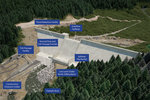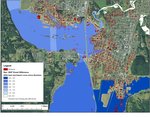



People from communities distant from ours have called in to public hearings regarding the emergency flood retention facility proposed for the main stem Chehalis River above Pe Ell asking, “Who will profit?”
The project applicant is the Lewis County Flood Zone District, an extension of county government. It will be a public facility. Who will profit? The project would not generate revenue or profit. It would serve as a means to store a huge amount of floodwater for a forecast average of a few weeks every seven to 10 years during our biggest floods. The rest of the time, the gates at the bottom of the facility would be open and the Chehalis River would flow at its normal rate and volume, as in nature, with fish able to pass up and down through the gates.
By far, the biggest beneficiaries if this facility is constructed are the families, small businesses, schools, churches, drivers on Interstate 5 and state highways 6 and 12 across the Chehalis Basin, who would receive protection, as well as drivers on many county roads and city streets. The facility would hold 65,000 acre-feet of flood water from the Chehalis main stem. Sixty-five-thousand acre-feet stretched horizontally is 101 square miles of water a foot deep. It is enough water to cover I-5 a foot deep and a mile wide from Centralia almost to Everett. Storing that much flood water would lower the peak flood in FEMA’s 100-year flood level from Pe Ell to Cosmopolis near the mouth of Grays Harbor. According to the recently published federal environmental impact statement (EIS) prepared by the Army Corps of Engineers, the facility in place will prevent damage to 1,300 homes and other valuable structures in the Chehalis Basin.
So, definitely those property owners would gain from the facility. But what about the rest of us?
A study commissioned by the state found that the 2007 flood caused almost $1 billion in damage. More than half of that economic damage hit families across the basin. State revenue and commerce lost because I-5 and the main BNSF rail line were closed, accounting for about a third of that $1 billion.
Since 1986 the basin has been hit by five floods greater than the then-modeled 100-year flood. The Lewis Economic Development Council estimates conservatively that not building this facility will result in $10 billion in damage over the remainder of this century. That level of damage will impact every family, business, school district, local government and community across the basin, as well as people across the state.
Besides the economic losses, everyone who lived here through the catastrophic 1990, 1996 and 2007 floods remembers the trauma that impacted children taken from their classrooms, farmers who watched their herds drown, homeowners and small business owners who had to choose between walking away or rebuilding.
A few critics say that people who choose to live in places that flood bring their own damage on themselves. What that ignores is that many flood victims here were living in homes that had not flooded in decades, if ever.
They were hit because the occasional catastrophic floods have been getting bigger. And we ask those critics: where should all of the families vulnerable to flooding from Pe Ell to Cosmopolis move? Puget Sound is due for the catastrophic Cascadia earthquake. Our eastern, central and southern states are hit by periodic catastrophic hurricanes and tidal surges. California residents live with the risk of the San Andreas fault giving way. Where is the safe place that people here should move to instead?
And, unlike all of those other regions of the country, we have a facility that will take the top off of our catastrophic events. This emergency flood facility will not prevent all flood damage. We will still have major floods with damage to our communities even after this facility is built. But no single measure will do more to protect more families and communities — by far — than this one.
The answer to the question “who will gain?” is “you.”
•••
This is the third installment of an ongoing series focusing on the proposed dam on the Chehalis River. Installments will be published in each Saturday edition of The Chronicle.